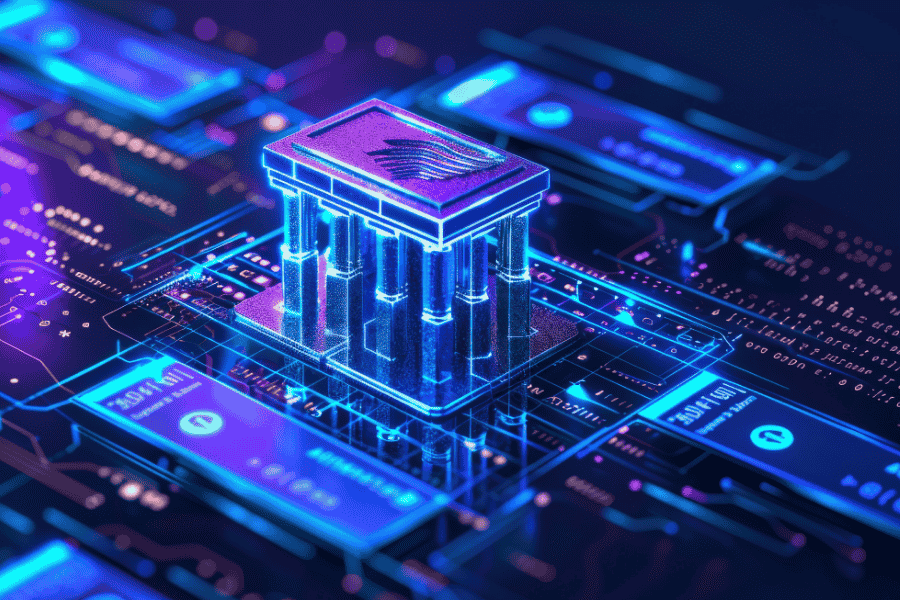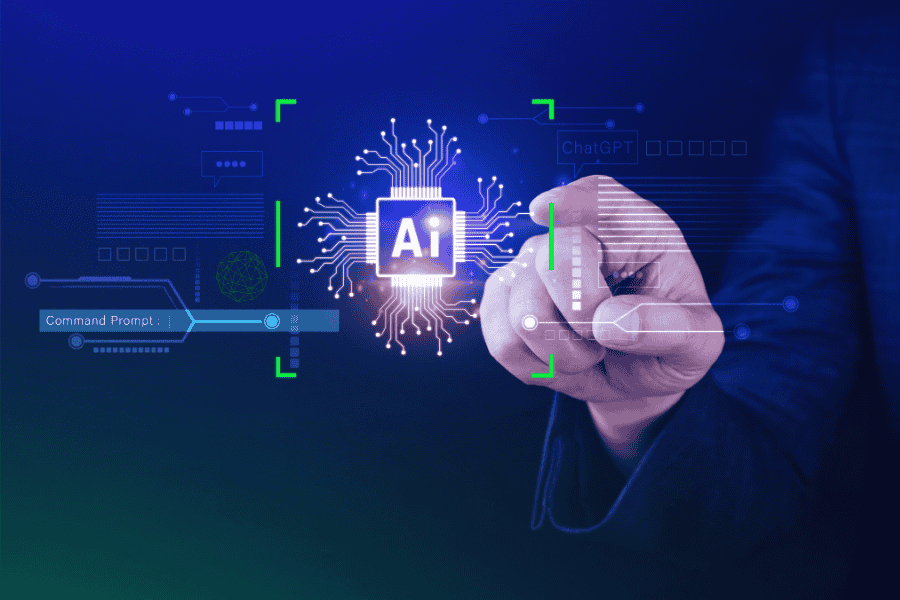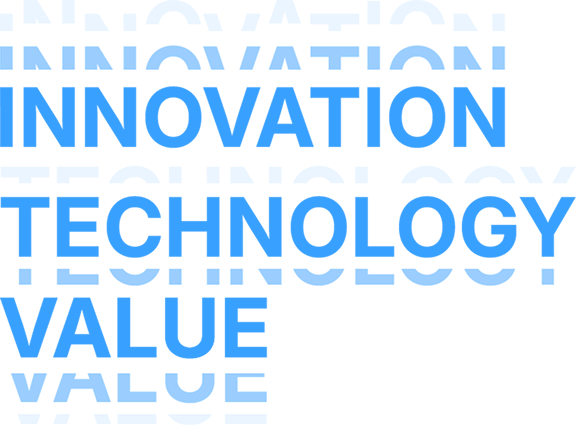Have you ever wished that there would be a day when your enterprise systems could think, adapt, and make intelligent decisions autonomously without moving a finger? Luckily, we no longer have to wait for the day. The AI agent represents the next evolution in business automation, combining artificial intelligence with autonomous decision-making to transform how organizations operate.
Yet, not all of us are AI experts to comprehend the power of such advanced technology. Therefore, together, let’s go through this comprehensive guide to see the AI agent definition, how they function, and AI agent examples across customer service, supply chain management, IT operations, and financial services. Moreover, you’ll discover implementation frameworks, real-world case studies from leading Asian enterprises, and actionable insights for calculating ROI and managing enterprise-wide deployments.
What are AI agents?
AI agents are intelligent, autonomous systems that can perceive their environment, make decisions, and take actions without constant human oversight. This represents a fundamental shift from traditional automation.
While conventional software simply executes preset commands, an AI agent operates through a sophisticated cycle of observation, analysis, and adjusts their approach based on changing conditions and accumulated experience. To sum up, what distinguishes AI agents from traditional tools is their capacity for goal-oriented behavior and adaptive decision-making.
This intelligence enables them to handle complex enterprise scenarios, from optimizing supply chain operations in real-time to providing personalized customer support that improves with each interaction.
How AI Agents Process and Decide? The Components of AI Agents
At their core, AI agents function through 04 interconnected components that work together seamlessly: the perception, the reasoning, the action, and the learning & adaptation mechanism.
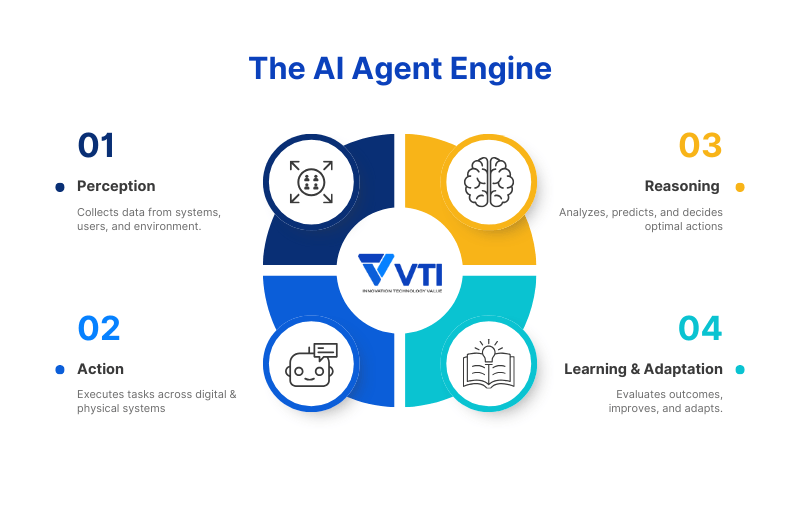
- The perception: Serves as the system’s sensory layer, gathering data from various sources such as digital interfaces, sensors, or enterprise system APIs. This component enables the agent to understand its current operational context, from network traffic patterns to customer service interactions or financial transactions.
- The reasoning: Forms the intelligent heart of any AI agent, where raw data transforms into actionable insights. This component employs sophisticated techniques, including machine learning algorithms, neural networks, and advanced reasoning frameworks like Chain-of-Thought processing to analyze information and make informed decisions. Modern AI agents can evaluate multiple scenarios simultaneously, weighing various factors such as business objectives, resource constraints, and risk parameters to determine optimal actions.
- The action: Completes the agent’s operational cycle by executing decisions through physical or digital interfaces. Whether adjusting server configurations, routing customer inquiries, or triggering automated workflows, these systems can operate across multiple enterprise platforms simultaneously, creating seamless integration opportunities for organizations across Asia seeking to modernize their operational infrastructure.
- The Learning and Adaptation: Enables the agent to improve its performance over time. Through a feedback loop, the agent evaluates the outcome of its actions and adjusts its internal models and decision-making processes. It learns from its experiences, allowing it to become more effective and adaptable in dynamic environments without constant human reprogramming.
What are the differences between an AI Agent and an AI Chatbot?
It is common for people to misunderstand these 2 AI entities.
Of course, both AI agents and chatbots use natural language processing and machine learning to interact with users. They can understand context, generate relevant responses, and learn from interactions to improve performance over time.
Yet, there are a few key distinctions that make them different from each other:
| AI Chatbots | AI Agents | |
| Purpose | Conversational tools for dialogue and information exchange | Autonomous systems for task execution and goal achievement |
| Function | Respond to user queries, provide information, and maintain conversations | Perceive environment, make independent decisions, execute complex tasks |
| Scope | Communication-focused, reactive to user inputs | Action-oriented, proactive in pursuing objectives |
| Use Cases | Customer service, FAQ assistance, general conversation | Scheduling systems, transaction processing, smart home control, workflow automation |
To sum up, the fundamental difference lies in their operational approach: chatbots excel at communication and information retrieval, while agents focus on independent action and task completion to achieve specific goals.
Types of AI Agents and Enterprise Applications
Reactive Agents: Real-Time Monitoring and Alert Systems
Reactive agents represent the foundational tier of AI agent architecture, operating through immediate stimulus-response patterns that make them ideal for enterprise monitoring and alert systems. These AI agents continuously scan their environment for specific conditions and trigger predetermined responses without maintaining historical context or complex reasoning capabilities.
The strength of reactive agents lies in their speed and reliability for well-defined scenarios. For example, in enterprise environments across Asia-Pacific markets, reactive agents excel in network security monitoring, instantly detecting abnormal traffic patterns and initiating automated containment protocols. They process incoming data streams in real-time, comparing current conditions against established thresholds to generate alerts, escalate issues, or execute immediate corrective actions. For IT managers overseeing critical infrastructure, these agents provide essential first-line defense capabilities that operate continuously without human intervention.
Model-Based Agents: Predictive Analytics and Strategic Planning
Model-based agents advance beyond simple reaction patterns by maintaining internal representations of their operational environment, enabling sophisticated predictive analytics and forward-looking decision support. These software AI agents build and continuously update models of their environment, allowing them to anticipate future states and optimize actions based on projected outcomes rather than just current conditions.
In enterprise applications, model-based agents excel in supply chain optimization, financial forecasting, and capacity planning scenarios where understanding trends and patterns drives strategic value. They analyze historical data, current market conditions, and operational constraints to generate actionable insights that support executive decision-making processes throughout Japan, Korea, and Singapore’s dynamic business environments.
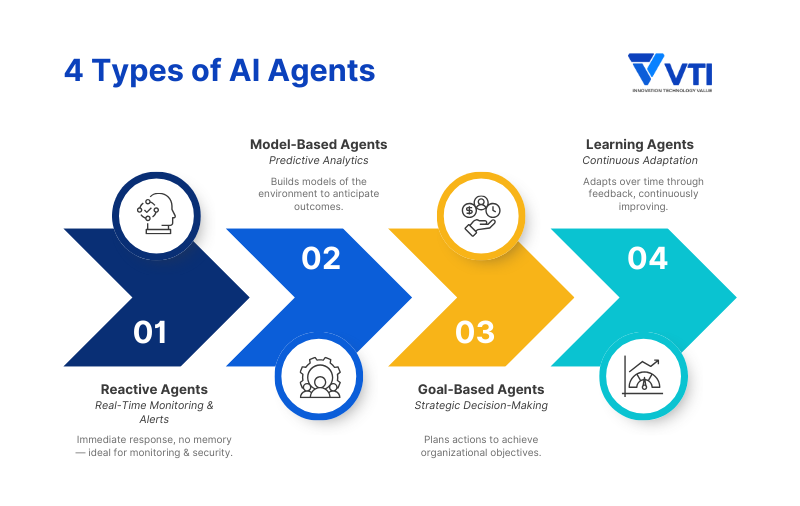
Goal-Based Agents: Strategic Decision Making and Process Optimization
Goal-based agents are advanced artificial intelligence applications, as they operate with explicit objectives and can evaluate multiple pathways to achieve desired outcomes.
Unlike reactive systems that respond to immediate stimuli, these AI agents demonstrate autonomous planning capabilities that align actions with long-term organizational goals while adapting strategies based on changing circumstances.
These agents excel in complex enterprise scenarios requiring strategic thinking, such as resource allocation optimization, project management automation, and customer experience orchestration. They evaluate trade-offs between competing objectives (prioritize actions based on business impact and continuously adjust their approach to maximize goal achievement) and operating within established constraints or compliance requirements.
Learning Agents: Continuous Process Optimization and Adaptation
Learning agents represent the most sophisticated category of AI agents, incorporating machine learning mechanisms that enable continuous improvement and adaptation based on experience and feedback. These systems combine the capabilities of goal-based reasoning with the ability to refine their performance over time, making them particularly valuable for complex enterprise applications where optimal strategies emerge through iterative refinement.
In practice, learning agents transform routine business processes by identifying optimization opportunities that human operators might overlook, adapting to changing business conditions automatically, and developing increasingly effective strategies for achieving organizational objectives. BCG research demonstrates that organizations implementing learning agents in their operational workflows achieve measurably superior performance outcomes compared to static automation approaches.
How AI Agents Transform Business Operations? – Enterprise AI Agents Examples
Customer Service Automation
AI agents are transforming customer service by providing intelligent, context-aware support that goes far beyond traditional chatbots. For example, in Singapore, banks using AI chatbots achieved 40% faster response times, while global studies show AI automation can cut customer support costs by about 30%. By 2029, 80% of routine service issues are expected to be resolved by AI agents.
These systems don’t just answer simple queries; they handle complex requests, process returns, update accounts, and escalate cases when needed, all while maintaining conversational continuity across multiple channels. Intelligent routing further optimizes delivery by matching inquiries to the right resources, continuously learning to boost personalization & reduce costs at scale.
Supply Chain Optimization and Demand Forecasting
Supply chain management is one of the most impactful AI use cases. IDC projects that by 2028, 60% of leading APAC supply chains will use AI/ML for dynamic planning, cutting disruption response time by 75% and reducing transport costs by about 5%. AI-driven forecasting also improves accuracy by up to 30%, leading to 20% fewer stockouts and 15% less overstock.
This enables enterprises, especially in APAC’s fast-moving markets, to balance inventory efficiency with customer demand, outperforming traditional forecasting methods.
Financial Risk Assessment and Compliance Monitoring
AI adoption in financial services is already mainstream: over 80% of APAC banks and payment firms now use AI for fraud detection and anti-money-laundering monitoring.
These systems flag anomalies instantly, generate audit trails, and adapt quickly to regulatory changes. While adoption in compliance automation is still growing (currently ~15% of firms using advanced AI ), the impact is clear: AI delivers standardized, scalable oversight that reduces risk and ensures regulatory adherence.
Human Resources and Talent Management Automation
AI is rapidly reshaping HR in APAC. A Workday survey found that 69% of organizations in the region already use AI/ML in HR, with adoption reaching 88% in ASEAN. AI hiring platforms can cut time-to-hire by 50% and lower recruiting costs by up to 30% by automating candidate screening, interview scheduling, and performance tracking.
Beyond recruitment, AI recommends training paths, analyzes engagement signals, and flags retention risks, helping enterprises build more resilient, future-ready workforces.
What to consider when implementing an AI Agent?
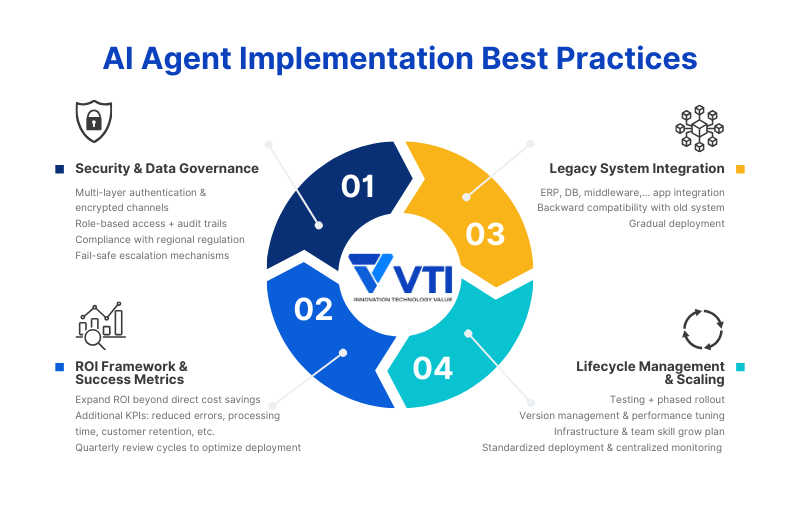
Enterprise-Grade Security and Data Governance Requirements
Implementing AI agents in enterprise environments demands comprehensive security frameworks that address the unique challenges of autonomous decision-making systems. AI agents require dynamic security protocols that can adapt to their evolving behavior patterns while maintaining strict data governance standards. Particularly, data governance becomes critical when AI agents access sensitive enterprise information across multiple systems and databases.
Therefore, it is a must that enterprise security architectures incorporate multi-layered authentication, encrypted communication channels, and continuous monitoring capabilities to ensure AI agents operate within authorized boundaries.
Also, organizations must establish clear data lineage tracking, implement role-based access controls that evolve with agent capabilities, and maintain audit trails that demonstrate compliance with regional regulations, such as Japan’s Personal Information Protection Act, Korea’s Personal Information Protection Act, and Singapore’s Personal Data Protection Act.
Furthermore, enterprises must design fail-safe mechanisms that prevent AI agents from accessing or modifying critical data without proper authorization escalation.
Legacy System Integration Strategies and Best Practices
Successful AI agent deployment requires sophisticated integration strategies that bridge modern artificial intelligence capabilities with existing enterprise infrastructure. Especially crucial in the case of many organizations across the Asia-Pacific, which are operating hybrid environments combining cloud services with on-premises legacy systems.
Modern AI agents need to interface with ERP systems, databases, middleware platforms, and custom applications through standardized APIs while maintaining backward compatibility with older protocols. Integration best practices emphasize gradual deployment approaches that minimize operational disruption while maximizing value realization.
Organizations should prioritize AI agent implementation in non-critical processes initially, allowing teams to build expertise and confidence before expanding to mission-critical operations. This phased approach enables IT teams to identify integration bottlenecks, optimize performance parameters, and develop robust monitoring frameworks that ensure seamless operation across diverse technology stacks.
ROI Calculation Frameworks and Success Metrics
Calculating return on investment for AI agent implementations requires comprehensive frameworks that capture both quantitative benefits and qualitative improvements across enterprise operations.
This is because enterprise AI applications deliver value through multiple channels, from process automation, predictive analytics, to intelligent resource optimization that compound over time. In other words, hard-to-measure processes. Meanwhile, traditional ROI calculations focus solely on measurable metrics, direct cost, for example; therefore, they barely reflect strategic advantages such as improved decision quality or increased operational agility.
Accordingly, it is suggested that AI-era ROI frameworks should be updated and incorporate more parameters to better capture performance, implementation costs, operational expenses, and projected benefit streams over multi-year periods. For instance, key performance indicators (KPI) must reflect both immediate operational improvements, such as reduced processing times, error rates, as well as strategic benefits, including improved customer retention, competitive positioning, or innovation index.
At the same time, it is necessary to establish quarterly review cycles that track actual performance against projected outcomes, enabling continuous optimization of AI agent configurations and deployment strategies.
Lifecycle Management: From Deployment to Scaling
Effective AI agent lifecycle management encompasses the complete journey from initial deployment through enterprise-wide scaling, requiring sophisticated orchestration capabilities that maintain performance standards while accommodating growth demands. Deployment phases must include comprehensive testing protocols, gradual rollout strategies, and real-time monitoring systems that detect performance anomalies before they impact business operations. Organizations need established protocols for agent version management, configuration updates, and performance tuning that ensure consistent service delivery as systems evolve.
The same as any IT project, scaling strategies for enterprise AI Agent should also address both technical and organizational dimensions, including infrastructure capacity planning, team skill development, and governance framework expansion. When growing from pilot projects to enterprise-wide implementations, organizations must develop standardized deployment processes, automated monitoring capabilities, and centralized management platforms that maintain operational excellence across diverse business functions and geographic locations throughout the Asia-Pacific region.
Final words
AI agents represent a fundamental shift from traditional automation to intelligent, adaptive systems that can transform enterprise operations across every business function. From predictive maintenance to fraud detection in Korean banking and supply chain optimization, these autonomous systems deliver measurable results through continuous learning and intelligent decision-making. As your organization evaluates AI agent implementation, focus on security frameworks, integration strategies, and phased deployment approaches that minimize risk while maximizing value. The enterprises already deploying AI agents are gaining competitive advantages that will be difficult to match.
![[FREE EBOOK] Strategic Vietnam IT Outsourcing: Optimizing Cost and Workforce Efficiency](https://vti.com.vn/wp-content/uploads/2023/08/cover-mockup_ebook-it-outsourcing-20230331111004-ynxdn-1.png)


